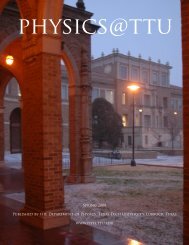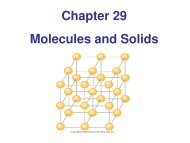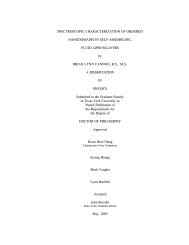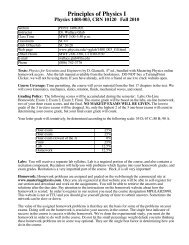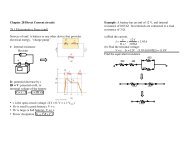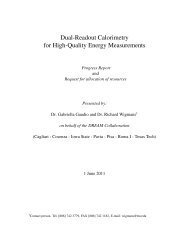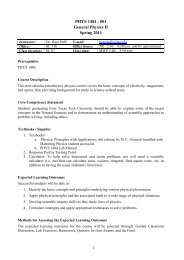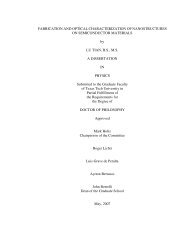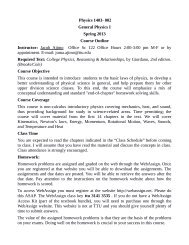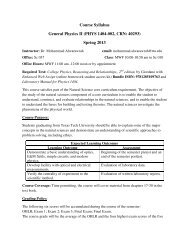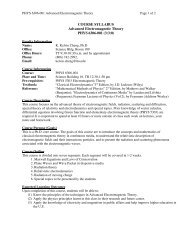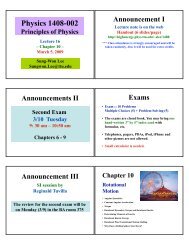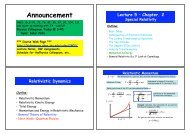Version One â Homework 1 â Juyang Huang â 24018 â Jan 16 ...
Version One â Homework 1 â Juyang Huang â 24018 â Jan 16 ...
Version One â Homework 1 â Juyang Huang â 24018 â Jan 16 ...
You also want an ePaper? Increase the reach of your titles
YUMPU automatically turns print PDFs into web optimized ePapers that Google loves.
Therefore<br />
<strong>Version</strong> <strong>One</strong> – <strong>Homework</strong> 1 – <strong>Juyang</strong> <strong>Huang</strong> – <strong>24018</strong> – <strong>Jan</strong> <strong>16</strong>, 2008 32<br />
C 12<br />
′ =<br />
2 κ<br />
C 12 1 + κ .<br />
4. U ′<br />
063 (part 2 of 3) 10 points<br />
of potential differences across<br />
V 2<br />
6. U ′<br />
2 κ<br />
1 + κ .<br />
V 2 = Q 2<br />
= V C 12<br />
= V C 2 C 2 2 .<br />
V 2 ′ = Q′ 2<br />
C 2<br />
′ = V C′ 12<br />
C 2<br />
′<br />
= V 1+κ<br />
κ C<br />
κ C = V<br />
1 + κ .<br />
V 2<br />
′<br />
= 2<br />
V 2 1 + κ .<br />
064 (part 3 of 3) 10 points<br />
of total energy stored in the<br />
U<br />
U = κ .<br />
The ratio V ′<br />
2<br />
capacitor C 2 for the two cases is<br />
1. V ′<br />
2<br />
V 2<br />
=<br />
2. V ′<br />
2<br />
V 2<br />
= κ .<br />
3. V ′<br />
2<br />
V 2<br />
= 2<br />
1 + κ . correct<br />
4. V ′<br />
2<br />
V 2<br />
= 1 + κ<br />
2 κ .<br />
5. V 2<br />
′<br />
= 1 + κ .<br />
V 2 2<br />
6. None of these.<br />
Explanation:<br />
For Case <strong>One</strong>,<br />
For Case Two,<br />
Therefore<br />
The ratio U ′<br />
capacitors for the two cases is<br />
1. None of these<br />
2. U ′<br />
U = 2<br />
1 + κ .<br />
3. U ′<br />
U = 1 + κ<br />
2 κ .<br />
5. U ′<br />
U = 1 + κ<br />
2<br />
U =<br />
Explanation:<br />
For Case <strong>One</strong>,<br />
For Case Two,<br />
Therefore<br />
keywords:<br />
.<br />
2 κ<br />
1 + κ . correct<br />
U = 1 2 C 12 V 2 .<br />
U ′ = 1 2 C′ 12 V 2 .<br />
U ′<br />
U = C′ 12<br />
C 12<br />
=<br />
2 κ<br />
1 + κ .<br />
Dielectric in a Capacitor 01<br />
26:05, trigonometry, multiple choice, > 1 min,<br />
wording-variable.<br />
065 (part 1 of 1) 10 points<br />
a) An isolated capacitor has a dielectric slab κ<br />
between its plates.<br />
b) The capacitor is charged by a battery.<br />
c) After the capacitor is charged, the battery<br />
is removed.<br />
d) The dielectric slab is then moved half way<br />
out of the capacitor.<br />
e) Finally, the dielectric is released and is set<br />
free to move on its own.<br />
κ<br />
The dielectric will<br />
1. be pulled back into the capacitor. correct<br />
2. remain in place.<br />
κ



